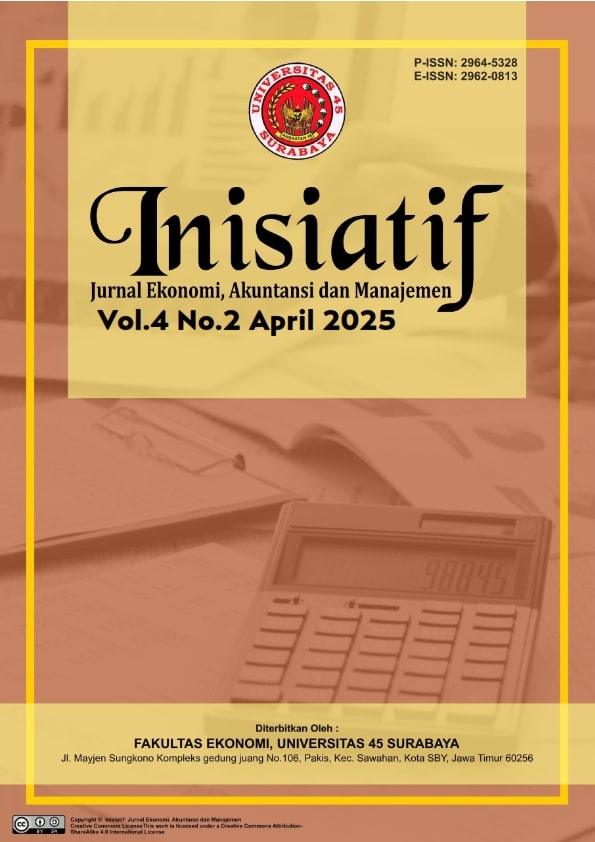Analisis Kepercayaan dan Niat Perilaku Konsumen dalam Menggunakan QRIS Guna Mendorong Pengembangan UMKM di Kota Surakarta
DOI:
https://doi.org/10.30640/inisiatif.v4i2.3734Keywords:
Mobile Usefulness, Trust, Attitude and Intention, Interest, QRISAbstract
The development of digital payment technology, particularly QRIS, facilitates cashless transactions and is expected to promote the growth of Micro, Small, and Medium Enterprises (MSMEs) by simplifying transactions between consumers and business owners. Surakarta was chosen as the research location due to its relatively low number of QRIS users, despite the significant potential to increase the adoption of digital payment systems. The study involved 105 respondents. The analysis results show that Mobile Usability significantly affects Interest, Attitude, and Intention (p < 0.05), while Trust does not significantly affect Interest but does influence Attitude and Intention. Attitude and Intention were found to significantly affect Interest. The model used has an R² value of 0.286 for Interest and 0.419 for Attitude and Intention, indicating that the model effectively explains the relationship between the independent and dependent variables. This study has limitations, including a small sample size and constructs that lack convergent validity, which need to be addressed in future research. The findings provide valuable insights into the impact of QRIS usage and trust on consumer attitudes and intentions in adopting digital financial technology, which is expected to support the development of MSMEs and the digital transformation in Surakarta.
References
Achmad, N., Kuswati, R., & Imronudin. (2021). Teori & Praktek Statistik Milenial. Jasmine Publisher.
Ahmadi, M. A. (2024). MANAJEMEN STRATEGI DALAM EVALUASI SWOT UNTUK USAHA MIKRO, KECIL, DAN MENENGAH (UMKM): LITERATURE REVIEW. Mount Hope Management International Journal, 2(1), 1–11. https://doi.org/10.61696/momil.v2i1.239
Annisa Annisa, & Mirzam Arqy Ahmadi. (2024). Pengaruh E-WOM dan Trust terhadap Purchase Intention dalam Belanja Online. Lokawati : Jurnal Penelitian Manajemen Dan Inovasi Riset, 3(1), 225–233. https://doi.org/10.61132/lokawati.v3i1.1488
Arikunto, S. 2010. Prosedur Penelitian Suatu Pendekatan Praktik. Jakarta: Rineka Cipta.
Ashrafi, D. M., & Easmin, R. (2023). The Role of Innovation Resistance and Technology Readiness in the Adoption of QR Code Payments Among Digital Natives: A Serial Moderated Mediation Model. International Journal of Business Science and Applied Management, 18(1), 18–45.
Badaruddin, and Risma. 2021. “Pengaruh Fitur Layanan Dan Kemudahan Terhdap Minat Menggunakan Mobile Banking (Studi Pada Masyarakat Desa Rantau Rasau Kecamatan Berbak).” Telanaipura Jambi 1(1): 36122.
Bara, Al., & Pradesyah, Riyan. 2021. Analisis Restrukturisasi Bagi UMKM Di Masa Pandemi. Seminar Nasional Teknologi Edukasi Sosial dan Humaniora, 1(1), p. 318–322.
Creswell, J.W. 2014. Research Design: Pendekatan Metode Kualitatif, Kuantitatif, dan Campuran. Yogyakarta: Pustaka Belajar.
Debasa, F., Gelashvili, V., Martínez-Navalón, J. G., & Saura, J. R. (2023). Do stress and anxiety influence users’ intention to make restaurant reservations through mobile apps? European Research on Management and Business Economics, 29(1). https://doi.org/10.1016/j.iedeen.2022.100205
Djayapranata, G. F., & Setyawan, A. (2021). 125958337 (1). 180(Insyma), 194–199.
Eren, B. A. (2022). QR code m-payment from a customer experience perspective. Journal ofFinancial Services Marketing, Bunmark 2017. https://doi.org/10.1057/s41264-022- 00186-5
Firmansyah, Aditia Iqbal. 2019. “1) (Firmansyah, 2019).” Pengaruh Pertumbuhan Usaha Mikro, Kecil, Dan Menengah Terhadap Pertumbuhan Ekonomi Di Tulungagung 53(9): 1689–99.
Fishbein, M and I Azjen. (1975). Belief, Attitude, Intention, and Behavior: An Introduction to Theory and Research. Reading, MA: Adisson-Wesley.
Henseler, J., Ringle, C. M., & Sarstedt, M. (2015). A new criterion for assessing discriminant validity in variance-based structural equation modeling. Journal of the Academy of Marketing Science, 43(1), 115-135.
Kurniawati, E. T., Zuhroh, I., & Malik, N. (2021). Literasi dan Edukasi Pembayaran Non Tunai Melalui Aplikasi QR Code Indonesian Standard (QRIS) Pada Kelompok Milenial. Studi Kasus Inovasi Ekonomi, 05(01), 23–30.
Lau, S., M. Wiedmann, and A. Adalja. 2022. “Consumer Perceptions of QR Code Technology for Enhanced Fluid Milk Shelf-Life Information Provision in a Retail Setting.” JDS Communications 3(6): 393–97. http://dx.doi.org/10.3168/jdsc.2022-0256.
Ledi, K. K., Ameza-Xemalordzo, E., Amoako, G. K., & Asamoah, B. (2023). Effect of QRcode and mobile money on performance of SMEs in developing countries. The role ofdynamic capabilities. Cogent Business and Management, 10(2). https://doi.org/10.1080/23311975.2023.2238977
Lou, L., Tian, Z., & Koh, J. (2017). Tourist satisfaction enhancement using mobile QR codepayment: An empirical investigation. Sustainability (Switzerland), 9(7), 1–14. https://doi.org/10.3390/su9071186
Rohmah, R. S., & Martini, E. (2021). Analisis niat konsumen dalam menggunakan qris di surakarta berdasarkan model decompossed theory of planned behavior analysis of consumer intention in using qris in surakarta based on the decompossed theory of planned behavior model. Jurnal Ekonomi Dan Bisnis, 8(3), 1–13. https://openlibrarypublications.telkomuniversity.ac.id/index.php/management/article/view/14925
Sanjaya, S., & Rizky, M. F. (2018). Analisis Profitabilitas Dalam Menilai Kinerja Keuangan Pada PT. Taspen (Persero) Medan. E-Journal UIN, 2(2), 277–293.
Studi, P., Syariah, P., Muhammadiyah, U., Utara, S., & Keamanan, P. (2023). Pengaruh persepsi kepercayaan dan persepsi keamanan terhadap minat penggunaan qris sebagai alat pembayaran digital umkm halal kota medan. 6(November).
Suharsimi, Arikunto. (2013). Prosedur Penelitian Suatu Pendekatan Praktik. Jakarta: Rineka Cipta.
Suo, Wen-Jing, Chai-Lee Goi, Mei-Teh Goi, and Adriel K. S. Sim. 2021. “Factors Influencing Behavioural Intention to Adopt the QR-Code Payment.” International Journal of Asian Business and Information Management 13(2): 1–22.
Tiara Imani, A., & Herlanto Anggono, A. (2020). Factors Influencing Customers Acceptance of Using the QR Code Feature in Offline Merchants for Generation Z in Bandung (Extended UTAUT2). KnE Social Sciences, 2020, 1174–1201. https://doi.org/10.18502/kss.v4i6.6670
Wan Nawang, W. R., & Syabil Nazhan Ahd.Moess. (2023). Predicting intention to use QR code mobile payment among Malaysian Muslim millennials. The Journal of Muamalat and Islamic Finance Research, 20(1), 49–63. https://doi.org/10.33102/jmifr.481
Yan, L. Y., Tan, G. W. H., Loh, X. M., Hew, J. J., & Ooi, K. B. (2021). QR code and mobile payment: The disruptive forces in retail. Journal of Retailing and Consumer Services, 58(May 2020), 102300. https://doi.org/10.1016/j.jretconser.2020.102300
Yuliati, T., & Handayani, T. (2021). Pendampingan Penggunaan Aplikasi Digital Qris Sebagai Alat Pembayaran Pada Umkm. Community Development Journal : Jurnal Pengabdian Masyarakat, 2(3), 811–816. https://doi.org/10.31004/cdj.v2i3.2612
Downloads
Published
How to Cite
Issue
Section
License
Copyright (c) 2025 Inisiatif: Jurnal Ekonomi, Akuntansi dan Manajemen

This work is licensed under a Creative Commons Attribution-ShareAlike 4.0 International License.








